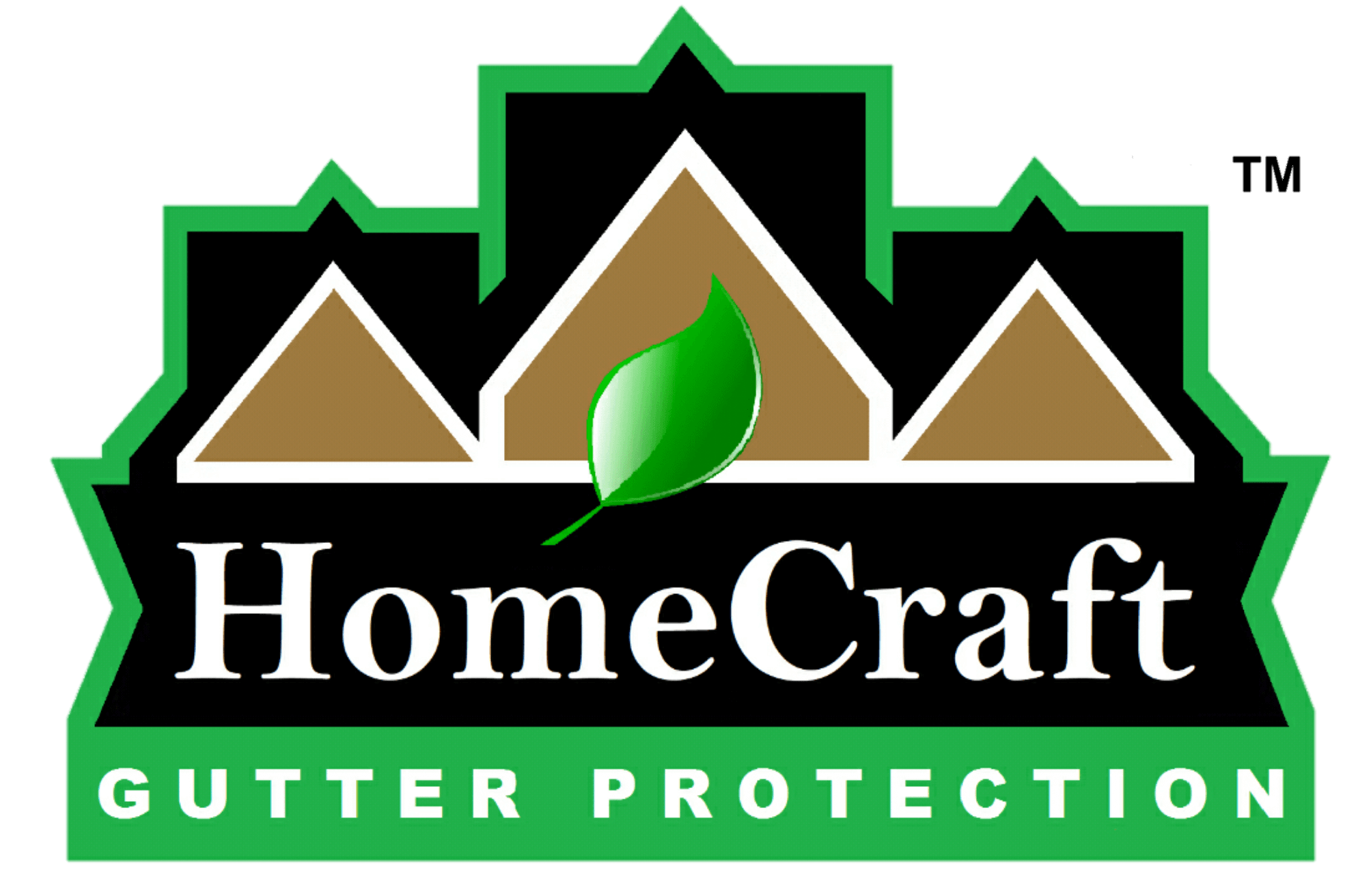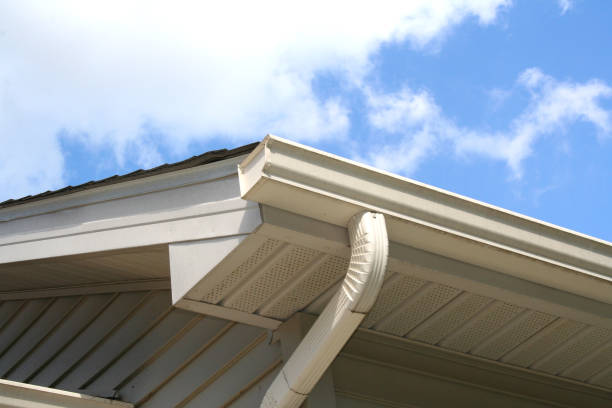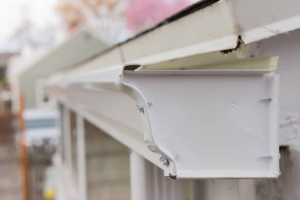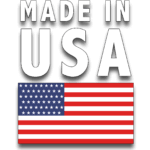Letter K is a very significant letter not only in the alphabet but also in different aspects of life depending on context (in baseball scorecard, it refers to strikeout). Similarly, the letter “K” also holds special significance in home improvement and roofing. “K-style gutters” are rain gutters for residential and commercial buildings. They are so named because of the shape of the gutter, which is similar to the letter “K.”
These gutters are known for their durability, versatility, and sleek appearance, making them a popular choice among homeowners and contractors. This blog post will delve deeper into K-style gutters, exploring their benefits, drawbacks, and what you should consider when choosing them for your home. Whether you are a homeowner looking to upgrade your rain gutters, or a contractor seeking information on the latest gutter styles, this article is for you.
Overview of K-style Gutters
The term K-style gutters get its name from the profile of this type of gutter when viewed from the side. The gutter’s outer edge consists of a short, straight line from the bottom, followed by two opposing curves. Another short straight line, which vaguely resembles the letter K. K-style gutters, are also sometimes referred to as ogee gutters, with “ogee” meaning “double curve.” The differences between K-style gutters and rounded gutters lie in their strength, water-holding capacity, and ease of cleaning.
K-style gutters have become the most widely used gutters in America due to their distinct advantages over rounded channels. They hold more water, are more robust, and are less likely to bend or protrude under the impact, even when lighter materials are used. However, K-style gutters also have more sharp edges where debris can accumulate and are harder to clean. The popularity of K-style gutters can also be attributed to the fact that they resemble stylish crown molding found on interior ceilings and blend better with modern architectural trends.
K-style gutters are often made with aluminum but can also be found in vinyl, copper, and galvanized steel. They are available in different sizes, the most common being five-inch and six-inch diameters, though custom sizes can be obtained from certain places. The price of K-style gutters depends mainly on the base material and length, with contractors often having portable gutter-making machines to make seamless K-gutters of a predetermined length.
Comparison to Other Gutter Styles
K-style gutters are one of the most popular due to their versatility and design. They are suited for professional installation and DIY projects and are available in 5-inch to 6-inch widths. Unlike half-round gutters, K-style gutters have a flat back, allowing them to be nailed directly to the fascia boards without brackets.
Additionally, they feature rectangular downspouts instead of the round ones seen in half-round gutters. While K-style gutters can be more challenging to clean than other styles, they hold more water than rounded gutters with the same diameter.
Custom fascia gutters are a more contemporary option, offering a seamless and custom-built design. These gutters are tailored to the home’s measurements and roof’s pitch and must be installed by a professional. However, they can be more expensive compared to half-round or K-style gutters.
Custom fascia gutters provide a seamless, contemporary look, but they are more expensive than K-style and half-round gutters and must be installed by a professional. Box-style gutters, often found in commercial or industrial buildings, are also more prominent and suited for homes with larger roofs.
Unlike K-style gutters, box gutters are not hung on the roof’s edge but instead use a high back section that tucks under the roof’s shingles. Box gutters are designed to handle heavy rainfall, but their installation requires professional help and can only be done while the home is being built.
Benefits of K-style Gutters
K-style gutters are popular among homeowners due to their sleek and modern appearance. They are more commonly used than half-round gutters and are favored for their versatility in modern homes. One of the main advantages of K-style gutters is their flat back, which allows them to be directly nailed into fascia boards without the need for brackets. This makes the installation process much more straightforward and efficient, reducing the risk of damage or leaks.
Another advantage of K-style gutters is their ability to hold more water than other gutters. This makes them an excellent choice for homes that experience heavy rainfall or have larger roof areas. The stylish appearance of K-style gutters adds to their appeal, and they come in various materials, including aluminum, copper, galvanized steel, and vinyl. Aluminum is the most popular choice due to its rust resistance, while copper is the most expensive option due to its durability.
K-style gutters are also easy to maintain, and their seamless design helps to prevent leaks and water damage. They are available in various sizes, ranging from 5-inch to 6-inch widths, making them suitable for different roof sizes. Furthermore, since K-style gutters are the most popular gutter shape, the seamless option is readily available, making it easier to find a gutter system that meets your needs.
The Durability of K-style Gutters
The K-style gutter is highly durable and can provide a clear drain path for the water to flow into the downspouts. They are more resistant to leakage and exterior damage than other gutters. The angular design of K-style gutters allows them to hold more water, making them a preferred choice among homeowners. The lifespan of K-style gutters can vary depending on the material used.
For instance, vinyl gutters have an average lifespan of up to 20 years, aluminum gutters can last from 20 to 30 years, galvanized steel gutters can last from 20 to 40 years, and copper gutters can last for over 50 years. The cost per linear foot of K-style gutters can also vary depending on the material. Vinyl gutters are the most cost-effective, while copper gutters are the most expensive due to their durability.
It is important to note that the lifespan of gutters can be affected by various factors such as climate, location, and routine maintenance. For example, in areas with high rainfall, gutters near the ocean will have a shorter lifespan than in dry environments with little rain. Regular maintenance, such as keeping the trough clear of debris and painting any exposed metal, can significantly extend the life of K-style gutters.
Aesthetic Appeal of K-style Gutters
Apart from being sturdy and durable, K-style gutters play a very important role in increasing the external beauty of your house. Their sleek and modern design makes them the first choice of gutters for many homeowners. They are designed to resemble crown molding found on interior ceilings, adding to the overall beauty of a home. The K-shape of the gutter not only adds to the sturdiness of the gutter but also makes it a great addition to modern constructions.
The sleek design and their compatibility with different types of roof designs of K-style gutters make them an attractive choice for homeowners who want to enhance the overall look of their homes. The angular design of these gutters provides a clean and elegant look, giving your home a touch of sophistication. The K-shape of these gutters creates a more uniform look along the roofline, which is impossible with round-style gutters or even box-style gutters.
Not only do K-style gutters have a modern look, but they also come in various materials and colors, which allows homeowners to find a style that can solve their problems. For example, K-style gutters can be made from aluminum, copper, galvanized steel, and vinyl and can be painted to match the color of your home. The seamless finish of K-style gutters provides a uniform look, an added advantage for homeowners who want to achieve a consistent aesthetic throughout their homes.
Cost of Installing K-style Gutter
You cannot talk about installing any gutters without mentioning their installation cost and whether it is achievable according to your budget. The cost of installing K-style gutters on your home is dependent on several factors. The size of your home, its architectural style, the amount and length of gutters needed, the difficulty of installation, and the number of downspouts required all play a part in determining the total cost.
Local contractor labor rates, the choice of gutter materials, and whether or not you need gutter guards also affect the price. The national average cost for K-style gutters is $11.63 per linear foot, but the actual cost can range anywhere from $8.25 to $15 per linear foot, depending on the above mentioned variables.
One factor that influences the cost of K-style gutters is the material used. Different material options are available, including aluminum, galvanized steel, copper, vinyl, and galvalume. Aluminum gutters are heavy-duty and rust-resistant, with a lifespan of up to 20 years. Galvanized steel k-style gutters are corrosion-resistant due to their zinc coating and the average cost of $4 to $8 per linear foot.
Copper is the most expensive option but is highly durable, with a lifespan of up to 50 years. Vinyl gutters are lightweight and easy to install, but their lifespan is shorter, and they are not recommended for areas with heavy rain or snow. Galvalume gutters are steel gutters with an aluminum and zinc coating that resists corrosion and rust.
The size and architectural design of your home also play a part in determining the total cost of K-style gutters. Larger roofs may require 6-, 7-, or 8-inch gutters, which cost more than 4- and 5-inch gutters. The brackets, end caps, mitered corners, and joints required to complete the gutter system also add to the final cost.
Elbows and downspouts are necessary to complete the system and will also affect the total cost. If you choose professional installation, you will incur labor costs ranging from $2.15 to $4 per linear foot, depending on your local labor rates.
Installing K-style Gutters
Installing K-style gutters involves a licensed gutter or roofing contractor determining the locations and measurements for the gutters and downspouts, and forming the gutters onsite from rolled aluminum using a roll-forming machine. The gutter troughs are then cut to the appropriate lengths and drilled with downspout holes.
The gutters must be hung with a slight slope and spaced no more than 36 inches apart, with a downspout for every 20-30 feet of gutter. Choosing the right gutter material, size, and slope, as well as installing gutter guards, is essential for ensuring proper drainage and preventing clogs and ice dams.
It is important to plan ahead by drawing the gutter system on paper and choosing the appropriate accessories, such as end caps, inside and outside corners, and mounting brackets. Sturdy gutters are recommended for areas with heavy rainfall, while larger gutters are needed for steep roofs.
Gutter guards can help keep leaves and debris out of the gutters, and those with heat cables can prevent ice dams from forming. A professional gutter installation ensures that the job is done correctly and safely, and can be completed in less than a day’s time.
Maintaining K-style Gutters
Maintaining K-style gutters is essential to ensure they remain functional and effective. Before cleaning gutters, ensure that you have all the necessary safety equipment, such as heavy work gloves, non-slip shoes, safety goggles, and a tall enough ladder.
While on the ladder, make sure your hips are always between the rails, never lean on the sides, and avoid working on the topmost two steps. Call a gutter professional to avoid unnecessary risks if your gutters are too high or close to power lines.
To repair minor rust spots on gutters, use a wire brush to scrape away the rust, and apply a thin coat of roofing cement using a putty knife. For clogged gutters, remove debris by hand while wearing gloves, use a wire brush to loosen stubborn accumulations, and rinse gutters with a hose to remove remaining dirt and leaves. To clear the roof of existing debris, hire professional roofing contractors or clean the roof if you understand “Roof Safety 101” and have a safe roof to clean.
Gutter guards are an excellent way to minimize the need for cleaning gutters. They fit over or inside gutters and are designed to prevent leaves, twigs, and other items from falling into the gutters. With gutter guards installed, you only need to brush the leaves and debris off the guards, eliminating the need to scoop and rinse the inside of the gutter.
Frequently Asked Questions
What are K-style gutters?
K-style gutters are a type of rain gutter for residential and commercial buildings that are named after the shape of the gutter, which is similar to the letter “K”. They are known for their durability, versatility, and sleek appearance. K-style gutters are made with materials such as aluminum, copper, vinyl, and galvanized steel and are available in different sizes, the most common being five-inch and six-inch diameters. K-style gutters are the most widely used gutters in America due to their distinct advantages over other gutter styles.
What is the difference between K-style gutters and rounded gutters?
K-style gutters and rounded gutters differ in their strength, water-holding capacity, and ease of cleaning. K-style gutters are stronger, hold more water, and are less likely to bend or protrude under impact. However, they have more sharp edges where debris can accumulate, making them harder to clean than rounded gutters.
How do K-style gutters compare to custom fascia gutters?
Custom fascia gutters are a more contemporary option, offering a seamless and custom-built design. These gutters are tailored to the home’s measurements and roof’s pitch and must be installed by a professional. However, they can be more expensive compared to half-round or K-style gutters.





Join the discussion One Comment